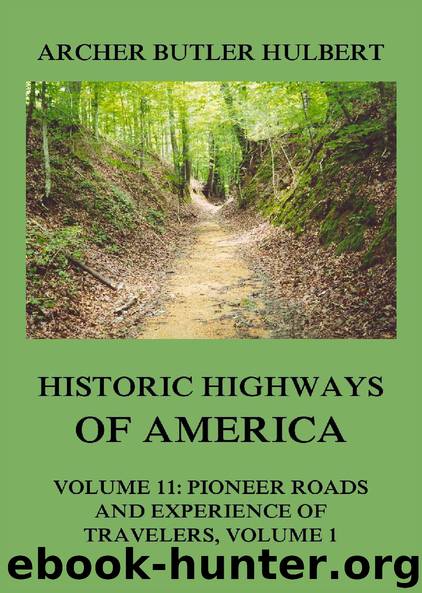Historic Highways of America: Volume 11: Pioneer Roads and Experiences of Travelers (I) by Archer Butler Hulbert

Author:Archer Butler Hulbert [Hulbert, Archer Butler]
Language: eng
Format: epub
Tags: Geschichte
Publisher: Jazzybee Verlag
Published: 2018-05-01T22:00:00+00:00
CHAPTER III - ZANE’S TRACE AND THE MAYSVILLE PIKE
In the study of the Ohio River as a highway of immigration and commerce it was emphasized that in earliest pioneer days the ascent of the river was a serious and difficult problem. This was true, indeed, not on the Ohio alone, but on almost every river of importance in the United States. Of course brawny arms could force a canoe through flood-tides and rapids; but, as a general proposition, the floods of winter, with ice floating fast amid-stream and clinging in ragged blocks and floes along the shore, and the droughts of summer which left, even in the Ohio, great bars exposed so far to the light that the river could be forded here and there by children, made even canoe navigation well-nigh impossible. For other craft than light canoes navigation was utterly out of the question in the dry seasons and exceedingly dangerous on the icy winter floods at night—when the shore could not be approached.
Such conditions as these gave origin to many of our land highways. Where pioneer homes were built beside a navigable river it was highly important to have a land thoroughfare leading back to the “old settlements” which could be traversed at all seasons. Many of our “river roads” came into existence, not because the valleys offered the easiest courses for land travel, but because pioneer settlements were made on river banks, and, as the rivers were often worthy of the common French name “Embarras,” land courses were necessary. In the greater rivers this “homeward track,” so to speak, frequently abandoned the winding valley and struck straight across the interior on the shortest available route.
The founding of Kentucky in the lower Ohio Valley offers a specific instance to illustrate these generalizations, and brings us to the subject of a thoroughfare which was of commanding importance in the old West. We have elsewhere dealt at length with the first settlement of Kentucky, making clear the fact that the great road blazed by Boone through Cumberland Gap was the most important route in Kentucky’s early history. The growth of the importance of the Ohio River as a thoroughfare and its final tremendous importance to Kentucky and the entire West has also been reviewed. But, despite this importance, the droughts of summer and the ice-torrents of winter made a landward route from Kentucky to Pennsylvania and the East an absolute necessity. Even when the river was navigable, the larger part of the craft which sailed it before 1820 were not capable of going up-stream. Heavy freight could be “poled” and “cordelled” up in the keel-boat and barge, but for all other return traffic, both freight and passenger, the land routes from Kentucky north and east were preferable. For many years the most available messenger and mail route from Cincinnati, Vincennes, and Louisville was over Boone’s Wilderness Road through Cumberland Gap. But, as the eighteenth century neared its close, the large population of western Pennsylvania and northwestern Virginia made necessary
Download
This site does not store any files on its server. We only index and link to content provided by other sites. Please contact the content providers to delete copyright contents if any and email us, we'll remove relevant links or contents immediately.
| Automotive | Aviation |
| History | Mass Transit |
| Owner's Manuals & Maintenance Guides | Railroads |
| Reference | Ships |
Small Unmanned Fixed-wing Aircraft Design by Andrew J. Keane Andras Sobester James P. Scanlan & András Sóbester & James P. Scanlan(32743)
Navigation and Map Reading by K Andrew(5111)
Endurance: Shackleton's Incredible Voyage by Alfred Lansing(4676)
And the Band Played On by Randy Shilts(2129)
Wild Ride by Adam Lashinsky(1933)
The Box by Marc Levinson(1931)
Top 10 Prague (EYEWITNESS TOP 10 TRAVEL GUIDES) by DK(1930)
The Race for Hitler's X-Planes: Britain's 1945 Mission to Capture Secret Luftwaffe Technology by John Christopher(1817)
The One Percenter Encyclopedia by Bill Hayes(1787)
Trans-Siberian Railway by Lonely Planet(1703)
Girls Auto Clinic Glove Box Guide by Patrice Banks(1684)
Bligh by Rob Mundle(1653)
Looking for a Ship by John McPhee(1630)
Batavia's Graveyard by Mike Dash(1607)
Good with Words by Patrick Barry(1602)
TWA 800 by Jack Cashill(1592)
Fighting Hitler's Jets: The Extraordinary Story of the American Airmen Who Beat the Luftwaffe and Defeated Nazi Germany by Robert F. Dorr(1591)
Troubleshooting and Repair of Diesel Engines by Paul Dempsey(1557)
Ticket to Ride by Tom Chesshyre(1543)
